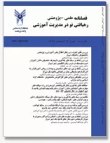The developing of Structural Model of Factors Affecting Intellectual Capital Growth among Faculty Members of Medical Universities
Author(s):
Article Type:
Research/Original Article (دارای رتبه معتبر)
Abstract:
The present descriptive-field study was conducted from 2013 to 2014. The data needed to identify the factors affecting the growth of intellectual capital, the extent of impact, the composition and the relationship between them on each aspect of intellectual capital, the presentation of the structural model and the determination of the degree of degree of fitness of the model, has been studied and analyzed. This study was conducted among the faculty members, with the degree of assistant professor and above, of the universities of medical sciences of Fars and Kohgiluyeh and Boyer-Ahmad provinces, with about 800 as a statistical population and 260 individuals as a statistical sample that were categorically sampled according to Krejcie-Morgan-sample-size-table. The instrument of the questionnaire was a researcher-made questionnaire developed by faculty members of all groups, using the Cronbach's alpha coefficient (0.947) for collecting data. The results showed that all of the identified components had an impact on the growth of intellectual capital among the faculty members of universities of medical sciences. In the dimension of organizational factors, the component of perceived organizational support with factor load was 0.79, in the dimension of human factors, professionalism with factor load of 0.88, and in the dimension of environmental factors, the component of scientific and trade associations with factor load of 0.84 had the highest impact. Among all the components that affect the growth of intellectual capital, the component of trade unions and academia in the environmental dimension with a factor of 0.84 had the utmost significance in influencing the growth of intellectual capital among faculty members. This pattern shows that the most influence on the growth of intellectual capital is the organizational factors dimension with the factor load of 95/0, then the environmental factors dimension with the factor load of 93/0, and finally the human factor dimension with the factor load of 92/0. Model fitting indicators suggest that the pattern of compliance indicators are satisfactory.
Keywords:
Language:
Persian
Published:
Journal of New Approaches in Educational Administration, Volume:9 Issue: 1, 2018
Pages:
225 to 246
magiran.com/p1864797
دانلود و مطالعه متن این مقاله با یکی از روشهای زیر امکان پذیر است:
اشتراک شخصی
با عضویت و پرداخت آنلاین حق اشتراک یکساله به مبلغ 1,390,000ريال میتوانید 70 عنوان مطلب دانلود کنید!
اشتراک سازمانی
به کتابخانه دانشگاه یا محل کار خود پیشنهاد کنید تا اشتراک سازمانی این پایگاه را برای دسترسی نامحدود همه کاربران به متن مطالب تهیه نمایند!
توجه!
- حق عضویت دریافتی صرف حمایت از نشریات عضو و نگهداری، تکمیل و توسعه مگیران میشود.
- پرداخت حق اشتراک و دانلود مقالات اجازه بازنشر آن در سایر رسانههای چاپی و دیجیتال را به کاربر نمیدهد.
In order to view content subscription is required
Personal subscription
Subscribe magiran.com for 70 € euros via PayPal and download 70 articles during a year.
Organization subscription
Please contact us to subscribe your university or library for unlimited access!


